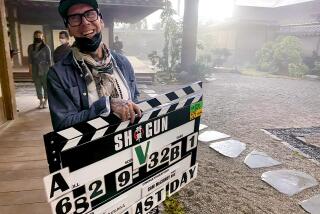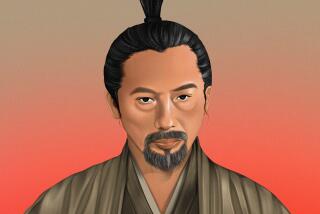MOVIE REVIEW : Shinoda’s ‘Gonza’ Unfolds as a Flawless Work
In “Gonza the Spearman” (at the Little Tokyo Cinema 1), director Masahiro Shinoda and his actress-wife Shima Iwashita have made a flawless film from the great playwright Monzaemon Chikamatsu’s 1717 work, with the help of screenwriter Taeko Tomioka and the legendary cameraman Kazuo Miyagawa.
The Shinodas’ earlier film from Chikamatsu, “Double Suicide” (1969), has become a classic. Both films--marking the heights of the Shinodas’ careers--are romantic tragedies derived from bunraku puppet plays. But the approach Shinoda has taken with “Gonza the Spearman” is diametrically different from the one he took with “Double Suicide.”
Shinoda has brought to “Gonza the Spearman” a realistic style of the utmost simplicity; the result is a calm, measured film in muted colors that almost imperceptibly builds suspense, keyed by Toru Takemitsu’s spare score. The film is the work of mature artists who know how to make less seem like more.
We’re in the early years of the Tokugawa Shogunate, a time when ambitious samurai were laying down their swords and trying to master the intricacies of the tea ceremony. To consolidate their power, the Tokugawas decreed that the provincial lords should spend alternate years at the capital of Edo.
It is while Ichinoshin Asaka (Takashi Tsumura), lord of the Matsue clan of Izumo in western Japan, is off in distant Edo that his wife Osai (Iwashita) proposes that her husband’s dashing clansman Gonza Sasano (Hiromi Go) marry her 15-year-old daughter in exchange for access to the Asaka family secrets regarding the art of the tea ceremony.
There are myriad complications, and when the two are observed at a midnight meeting they are hopelessly compromised, in spite of the fact that they are having a violent argument rather than making love.
Miyagawa’s camera lingers on the minimalist perfection of the Asakas’ traditional Japanese home and garden to suggest an atmosphere of serenity so soon at odds with the turmoil into which Osai and Gonza are so desperately plunged.
Until its climax “Gonza the Spearman” is a film of almost no action, unfolding as a series of breathtakingly composed tableaux, yet it develops tension. That’s because its images express the rigidity that imprisons Osai and all the people of her artificial world; no wonder late in the film she discovers herself envying the lives of simple farmers.
Yet “Gonza the Spearman” (Times rated Mature for complex adult themes) is too sophisticated to be urging a return to nature. Instead, it moves beyond such a fleeting yearning in Osai to proceed to illuminate the paradox at the heart of the traditional Japanese character, which is that the ritualized codes of honor and behavior that wantonly destroy lives also give them meaning. ‘GONZA THE SPEARMAN’
A Shochiku release of a Shochiku/Hyogensha production. Executive producers Kiyoshi Iwashita, Masayuki Motomichi, Masatake Wakita. Director Masahiro Shinoda. Screenplay Taeko Tomioka; based on the play “Spearman Gonza’s Illicit Love” by Monzaemon Chikamatsu. Camera Kazuo Miyagawa. Music Toru Takemitsu. Art director Koyoshi Awazu. With Hiromi Go, Shima Iwashita, Shohei Hino, Misako Tanaka, Haruko Kato, Takashi Tsumura, Kaori Mizushima, Hideji Otaki, Choichiro Kawarazaki. In Japanese, with English subtitles.
Running time: 2 hours, 7 minutes.
Times-rated: Mature.
More to Read
Only good movies
Get the Indie Focus newsletter, Mark Olsen's weekly guide to the world of cinema.
You may occasionally receive promotional content from the Los Angeles Times.









